| Seymouriamorpha | |
|---|---|
 | |
| Fossil of Seymouria in the National Museum of Natural History | |
| Scientific classification | |
| Domain: | Eukaryota |
| Kingdom: | Animalia |
| Phylum: | Chordata |
| Clade: | Reptiliomorpha (?) |
| Order: | † Seymouriamorpha Watson, 1917 |
| Subgroups | |
Seymouriamorpha were a small but widespread group of limbed vertebrates (tetrapods). They have long been considered stem-amniotes (reptiliomorphs), and most paleontologists still accept this point of view, but some analyses suggest that seymouriamorphs are stem-tetrapods (not more closely related to Amniota than to Lissamphibia). [2]
Contents
Many seymouriamorphs were terrestrial or semi-aquatic. However, aquatic larvae bearing external gills and grooves from the lateral line system have been found, making them unquestionably non-amniotes. As they matured, they became more terrestrial and reptile-like. They ranged from 30 cm (1 ft) long lizard-sized creatures to the 1.5 m (5 ft) long Enosuchus . If seymouriamorphs are reptiliomorphs, they were the distant relatives of amniotes.
Seymouriamorphs are divided into three main groups: Kotlassiidae, Discosauriscidae, and Seymouriidae, which includes the best-known genus, Seymouria . The last seymouriamorphs became extinct by the end of the Permian. [3]
They have been considered to be the makers of the trace fossils placed in the ichnogenus Amphisauropus . [4]

